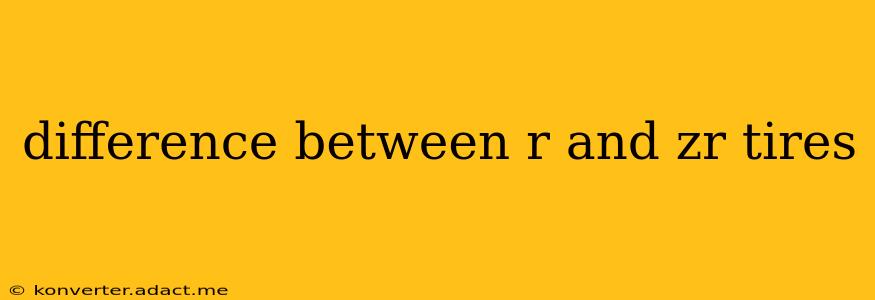Choosing the right tires for your vehicle is crucial for safety, performance, and handling. One common point of confusion for drivers is the difference between "R" and "ZR" tires. These designations aren't about tire size or tread pattern; they refer to speed ratings, indicating the maximum safe speed at which the tire can operate. Understanding this distinction is essential for selecting tires that meet your vehicle's needs and your driving style.
What Does the "R" in R Tires Mean?
The "R" designation in a tire's size code signifies that the tire is a radial tire. Almost all modern passenger car tires are radial tires. Radial tires have layers of fabric or cord running radially (from the center to the edge) providing better stability, fuel efficiency, and a smoother ride compared to older bias-ply tires. The "R" itself doesn't specify a speed rating; that information is provided separately with a letter code. For example, a "91H" rating indicates a tire's load capacity and speed capability (H being the speed rating).
What Does "ZR" in ZR Tires Mean?
"ZR" tires are high-performance radial tires with an extremely high speed rating. The "ZR" designation indicates that the tire is designed for speeds exceeding 149 mph (240 km/h). Crucially, the "ZR" designation doesn't replace the speed rating letter; it adds to it. A tire marked "275/35ZR19" signifies it's a high-speed radial tire, but the specific speed rating (like Y or (W) would still be indicated separately on the tire's sidewall.
What is the difference in performance between R and ZR tires?
The key difference boils down to speed capability and construction. ZR tires are built with stronger materials and a more robust construction to handle the stresses of high-speed driving. This results in:
- Higher Speed Rating: The most significant difference. ZR tires are explicitly designed for speeds significantly exceeding those of standard R tires.
- Enhanced Durability: The reinforced construction offers increased resistance to punctures and other damage, especially at high speeds.
- Improved Handling at High Speeds: ZR tires typically provide superior responsiveness and stability at high velocities.
- Potentially Stiffer Ride: The stronger construction may result in a slightly firmer, less comfortable ride compared to some standard R tires.
What is the difference in cost between R and ZR tires?
ZR tires are generally more expensive than standard R tires because of their enhanced construction and materials. The higher manufacturing cost translates to a higher price tag for consumers.
How do I know what speed rating I need?
The speed rating required for your vehicle is specified in your owner's manual. Never use tires with a speed rating lower than what's recommended. Using a tire with an insufficient speed rating can severely compromise safety and handling, especially at high speeds.
Are ZR tires always necessary?
ZR tires are not necessary for everyday driving. Unless you regularly drive at very high speeds, a high-performance R-rated tire with a suitable speed rating (such as W or Y) is often sufficient. ZR tires are best suited for high-performance vehicles or those frequently driven at or near their maximum speed capabilities.
Do I need ZR tires if my car has a high top speed?
Even if your vehicle has a high top speed, it doesn't automatically mean you need ZR tires. The manufacturer's recommendation in your owner's manual takes into account various factors, including the vehicle's design, braking system, and overall capabilities. Always adhere to those recommendations.
By understanding the differences between R and ZR tires, you can make informed decisions when purchasing new tires and ensure your vehicle's safety and performance are optimized. Remember to always consult your vehicle's owner's manual for specific tire recommendations.
